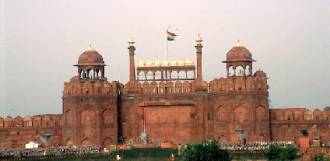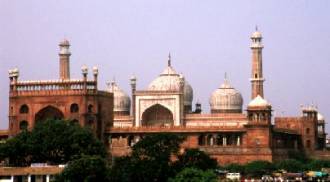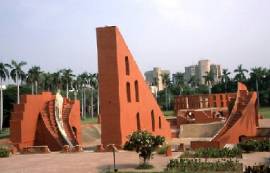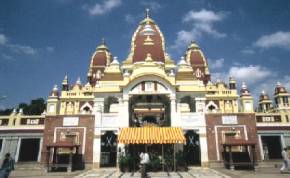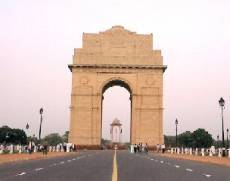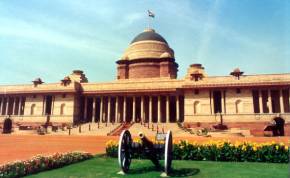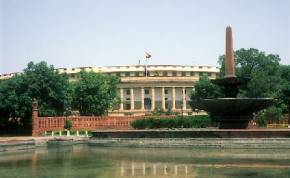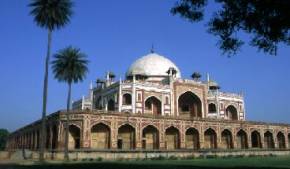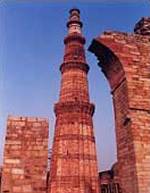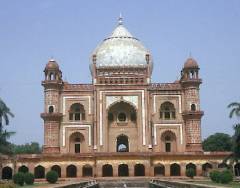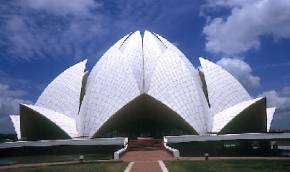Delhi is the capital of India and the third largest city in the country (10 million inhabitants). Its geographical position makes Delhi a hub of Central Asia. Like all the megalopolises of India, Delhi suffers from its overpopulation and pollution. The city has always played an important role in the history of India although it has not always been the capital of the country. Legend has it that Delhi was built and destroyed seven times and that anyone who builds a new city in Delhi sees its empire collapse, which has indeed proven to be true several times. Historians agree to fix the number of new cities built in Delhi to nine, which are:
- Indraprastha: 1450 BC Constructed by the legendary Pandava, hero of the Mahabharata.
- Lal Kot: 1060. Built by the rajput Tomara clan.
- Siri: 1304. Built by Ala-ud-Din. Some portions of the walls can still be seen.
- Tughlaqabad: 1321. Built by Ghiyas-ud-Din Tughluq. Ruins of buildings and walls are still visible.
- Jahanpanah: Mid-fourteenth century. Built by Muhammad-bin-Tughluq.
- Ferozabad: 1354. Built by Firuz Tughluq. It remained the capital until Agra became its capital. From its ruins the column of Ashoka always rises.
- Dilli Sher Shahi: 1534. Its construction was initiated by the Mughal Humayun, pursued by Sher Shah and terminated by the Suri. There are doors, walls, a mosque and a large well.
- Shajahanabad: Mid-seventeenth century. Built after the Mughal emperor Shah Jahan decided to move from Agra and rebuild his capital Delhi. This town corresponds today to Old Delhi (the Red Fort, Jama Masjid, etc.)
- New Delhi: Built in the 1920s after moving from the capital of British India from Calcutta to Delhi. The architect Edwin Lutyens designed the main administrative buildings still used today (Parliament, Presidential Palace, Supreme Court, etc.)
The red fort
The construction of the Red Fort, or Lal Quila, was decided by Shah Jahan in 1638 and completed 10 years later. The wall is 2km long and its height varies between 18 and 33 meters. The fort contains all the signs of Mughal power: private and public courtrooms, palaces, pavilions, a mosque, gardens. The Yamuna River once filled the dried moat. The entry into the fort is via the Lahore Gate so named because it faces Lahore in Pakistan. This door was a symbol in the struggle for independence and the great political discourse is always there. It opens onto the Chatta Chowk, a covered street lined with small stalls occupied by craftsmen. Another gate, the Delhi Gate, is to the south of the fort. It is flanked by two pretty statues of elephants. The Chatta Chowk ends at the Naubat Khana, or House of the Drum. This was where the musicians played for the emperor and for the rank-and-file visitors.
The fort houses two large public rooms: the Diwan-i-Am, the other private: the Diwan-i-Khas. In the first the emperor received the complaints of the people seated in an alcove of marble decorated with precious stones. In the second he received his intimates. In this room was the famous Throne of the Peacock, a masterpiece of gold and precious stones that was taken to Iran by Nadir Shah in 1739. The Diwan-i-Khas, symbol of the central power, was sacking several times after the collapse of the Mughal empire.
Further south is the Mahal Range, or Palace of Colors. It owes its name to the paintings that have disappeared. It housed the Emperor's wives and mistresses. It had a gold-plated ceiling that was reflected in a pool carved out of marble flooring. Many other monuments stand in the fort including the Royal Baths, various museums and the Moti Masjid (Pearl Mosque) built by Emperor Aurangzeb for his personal use. Its walls reproduce the architectural symmetry of the fort.
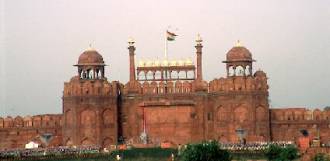
The red fort
The Jama Masjid
Il fut construit au XVIIe siècle par la Compagnie des Indes Orientales pour protéger ses intérêts. Aujourd'hui il abrite le Secrétariat et l'Assemblée législative. On y trouve aussi l'église Sainte Marie, construite en 1678. C'est la plus ancienne église anglicane de l'Inde. Le fort abrite un musée conservant de nombreux objets datant de la glorieuse époque de la Compagnie des Indes.
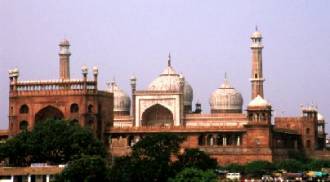
The Jama Masjid
The Chandni Chowk
It is the main artery of Old Delhi. It is actually a huge bazaar, overcrowded and polluted. At its eastern end is an interesting bird hospital managed by the Jainas, a temple, the Sisgunj Grudwara, stands nearby. This temple with gilded domes was built in memory of the ninth guru jaina, Teg Bahadur, beheaded there by Aurangzeb in 1675.
The Jantar Mantar
It was built in the 17th century by the Compagnie des Indes Orientales to protect its interests. Today it houses the Secretariat and the Legislative Assembly. It is also the church of Santa Maria, built in 1678. It is the oldest Anglican church in India. The fort is home to a museum with many objects dating from the glorious era of the India Company.
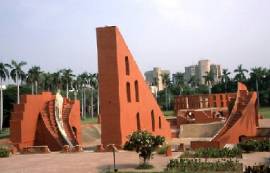
The Jantar Mantar
The temple of Lakshmi
Commonly called Birla Mandir because it was built by a wealthy family, the Birla, in 1938, this temple is dedicated to the goddess Lakshmi. Gandhi agreed to inaugurate it on the sole condition that all, especially the untouchables, could penetrate there. A plaque at the entrance recalls this promise. The feast of Janmashtami, which marks the birth of Krishna, is especially celebrated here.
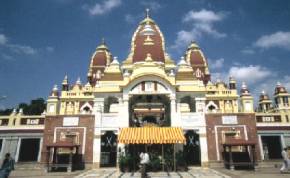
The temple of Lakshmi
The India gate
This 42-meter-high triumphal arch was erected by the British in memory of 85,000 Indian soldiers who lost their lives during the First World War and the Afghan War of 1919. Under the arc burns a flame of the unknown soldier lighted after the Indo-Afghan War of 1971.
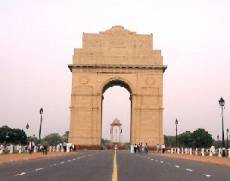
The India gate
The Rashtrapati Bhawan
Today the residence of the President of the Republic, this building was once the Palace of the Viceroy. Its construction was completed in 1929 and its style is an elegant blend of Mughal and English architecture. The main staircase leads to a 12-column portico. The most remarkable point of the building is its copper dome, which overlooks the Durbar Hall, a circular room measuring 23 meters in diameter. It is in this room that the great official ceremonies take place.
To the west of the Palais lies the Mughal Garden, a large garden designed by Edwyn Lutyens. The public is admitted to it from the spring after issuance of an authorization from the Ministry of Tourism.
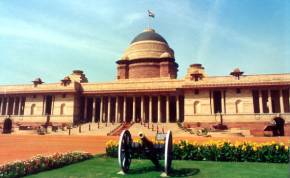
The Rashtrapati Bhawan
The Sansad Bhawan
Built in the 1920s by Robert Byron, this building now houses Parliament. It is a circular building of 173 meters in diameter crowned with a dome culminating at 27 meters high. It is divided into three semicircular spaces housing the Lok Sabha (House of the People), the Raya Sabha (Council of States) and the Library. A veranda with 144 columns surrounds the three rooms. The visit can be done after obtaining an authorization from the reception and on presentation of a letter of recommendation from your embassy.
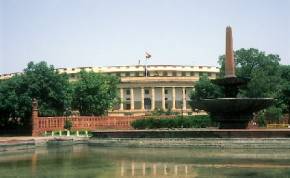
The Sansad Bhawan
The tomb of Humanyun
The tomb of the second Mughal Emperor was built by his wife Hamida Banu, also known as Bega Begum, in 1565. The building's architecture was said to inspire the construction of the Taj Mahal. It stands in the middle of a square garden of Mughal style itself divided into squares by paved alleys. One of the sides of the tomb has no wall because at the time of construction the river flowing there was supposed to represent the fourth wall. Unfortunately this river does not flow there today.
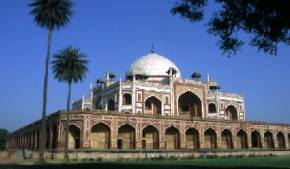
The tomb of Humanyun
The qutab Minar
The construction of this tower was undertaken in 1193 by Qutab-ud-Din Aibak after his victory against the Hindus of Delhi and completed by Feroz Tughlaq in 1368. It is not clear whether this is a tower of victory or a minaret for the nearby mosque. It measures 72.5 meters high for 14 meters in diameter at the base and 2.75 meters at the top. It is the tallest stone tower in India. Progressive balconies adorn each of the five floors.
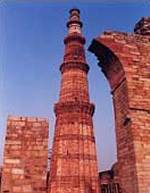
The qutab Minar
The tomb of Safgarjung
The tomb of Mirza Abul Mansur Khan, known as Safdarjung, was built by his son in 1753. It takes roughly the plans of the tomb of Humayun but smaller. The two-storey building is in the middle of a Mughal garden. It is one of the last buildings of its kind built before the collapse of the Mughal empire.
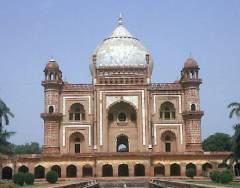
The tomb of Safgarjung
The Bahaï temple
This temple, built in the 1980s, is open to all religions, all can come to pray there, without distinction of class or race. There are no clergy and the rites consist of reading Baha'i holy texts or other religions. This building owes its fame to its lotus-shaped architecture. In the evening it is illuminated by spotlights.
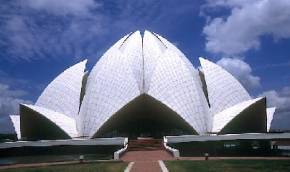
The Bahaï temple
History
The first city of Delhi was therefore that of Indraprastha, founded by the legendary Pandava, the hero of the Mahabharata. But it was only in the eleventh century that the city really grew with the arrival of the Rajputs of the Tomara clan. Their sovereign, Raja Anang Pal, built Lal Kot. The city was taken by the Rajputs of the Chauhan clan in the twelfth century. However, Delhi was not yet the seat of any central authority, and at the time no leader could control the region long enough to establish a kingdom. The Rajputs were constantly at war with one another.
In 1185 the Turkish Muhammad of Ghur took Lahore and crushed the Rajputs during the battle of Tarian in 1192. Delhi and Ajmer were then controlled by the Turks. Muhammad of Ghur returned to his kingdom leaving the direction of his new territories to Qutb-ud-Din Aibak. The latter declared himself Sultan of Delhi in 1206 to the death of Muhammad of Ghur, thus giving birth to the Sultanate of Delhi. The region was then regarded as a state in its own right and no longer an extension of the Afghan kingdom. Qutb-ud-Din Aibak died in 1210. The nobles then put Aram Shah on the throne before replacing him eight months later by Malik Shams-ud-Din Iltutmish. He strengthened the position of the Sultanate of Delhi by pushing back the Afghans and the Rajputs. it was he who made Delhi his capital. Iltutmish died in April 1236. His daughter Razziya was appointed to succeed him. The Sultana, to the great displeasure of the nobles, ruled the Sultanate for four years. His reign was followed by that of Bahram Shah (1240-12), Ala-ud-Din Masud Shah (1242-46) and Nasir-ud-Din Mahmud (1246-66). Then Ghiyas-ud-Din Balban came to power. He was undoubtedly the greatest Sultan of the dynasty. He inherited a territory weakened and attacked on all sides by the Mongols and Rajputs. He consolidated the borders by building citadels with soldier-soldiers. The Mongols were repulsed twice in 1279 and 1285. One of the great merits of Balban was to have organized and secured Delhi for the dynasties to come.
The founder of the first Delhi dynasty was left to the Khalji, who came to power in 1290, headed by Jalal-ud-Din Feroze Khalji. The latter was assassinated by his nephew Ala-ud-Din in 1296. He proclaimed himself a sultan of Delhi before obtaining the support of the nobility and the people thanks to the accumulated gold. One of Ala-ud-Din's great successes was to permanently remove the Mongol threat after their last invasion in 1308. His policy of expansion made Ala-ud-Din the real emperor of the 'India.
After the death of Ala-ud-Din, severe dissensions permitted the Tughluq to succeed the Khalji on the throne of Delhi. Three of the historic towns were built during the reign of the Khalji (Tughlaqabad, Jahanpanah and Ferozabad). Ghazi Malik inaugurated the dynasty under the name of Ghiyas-ud-Din Tughluq. His son Muhammad-bin-Tughluq succeeded him after a brief reign in which he built Tughlaqabad. He was the first to regard India as a country in its own right, and he imagined that his leader could be the master of Central Asia. He sent missions to China, Egypt and many other countries. Very tolerant, he opened many positions of responsibility to the Hindus. He began construction of the fifth city of Delhi (Jahanpanah). His most unfortunate decision was to move his capital from Delhi to Daulatabad (1000 km to the south!) By forcing the population to follow him. But once there he changed his mind and turned around. Most of the inhabitants did not survive the journey and Delhi lost much of its grandeur. He died in 1351.
His nephew Firuz succeeded him. He was the greatest builder of Delhi. He built the sixth city (Ferozabad), four mosques, 30 palaces, 200 caravanserais, tanks, hospitals, etc. Very loved by his people, his reign was, however, that of decline. His death in 1388 was followed by the succession of sultans all more inept than the others. The civil war settled and allowed Tamerlane to invade North India in 1398. In December 1398 he took Delhi and sacked the city in an indescribable bloodbath. In March 1399 Tamerlane left India, leaving behind a devastated Delhi. A new dynasty emerged from the ruins, that of the Sayyid. The founder of the dynasty was Khizr Khan, followed by Mubarak Shah, then Muhammad Shah. The latter had the bad idea of abusing his powers. Under popular pressure, he transferred power to Bhalul Lodi in 1451. The latter inaugurated the last dynasty of the Sultanate of Delhi, that of the Lodi. He successfully fought many battles. In 1489 his son Sikandar succeeded and decided in 1504 to build Agra and make it its capital. But the charms of Agra had no effect on his successor, Ibrahim Lodi, who preferred to return to Delhi. He had to undergo several rebellions. He was so severe that the governor of Punjab appealed to the Mughal Babur to rid him of this autocratic sultan. Too happy with this opportunity, Babur crossed the Indus in 1526 and victoriously confronted the armies of Ibrahim Lodi in Panipat. The latter died in Delhi that same year.
In 1530 Babur died leaving the foundations of the Mughal empire to his successor Humayun. This one consecrated its beginning of reign to consolidate its positions. But he was a bad strategist and lost a lot of ground and was forced into exile in Iran after his defeat against the Suri of Sher Shah in 1543. The Suri took control of Delhi and kept it until 1555. That year Humayun relieved the Indus, and quickly seized Lahore, Delhi, and Agra. Sher Shah and Humayun were the builders of the seventh city of Delhi.
The two following kings, Akbar (1556-1605) and Jahangir (1605-1627), made little mention of the history of Delhi, as they spent very little time there. Akbar, perhaps the greatest king that India has known, preferred Agra to Delhi and built Fatehpur Sikri to make it its capital. Jahangir spent his time between Agra, Lahore and Kashmir.
Delhi returned to the front of the stage with Shah Jahan, the rebellious son of Jahangir. His reign was hailed as that of the golden period of the Mughal empire because he was relatively peaceful and prosperous. Shah Jahan was the greatest builder of the dynasty. In 1639 he decided to build a new city in Delhi (Shahjahanabad). His masterpiece was obviously the Taj Mahal, built in memory of his wife Mumtaz Mahal. He was nevertheless a despot and a fundamentalist Muslim. In September 1657 he fell ill and was imprisoned by his own son Aurangzeb until his death in 1666.
The reign of Aurangzeb was marked by a religious fundamentalism which the Hindus suffered enormously. His reign was the longest in the dynasty and he led a state that had never been so extensive. He died in 1707. Bahadur Shah succeeded him at the age of 63 years. His reign marked the beginning of the decline of the Mughal empire. Of the 19 Mughal emperors who succeeded Aurangzeb, 13 were crowned between 1707 and 1837. The weakening of Delhi benefited the Persian king Nadir Shah who entered Delhi on 11 March 1739 by massacring the population. He left 57 days later with the famous throne of the Mughals, the Throne of the Peacock. In January 1757, Ahmad Shah Abdali, a former general of Nadir Shah, captured Delhi. For several decades the history of Delhi was marked by local struggles. In 1803 the Mughals appealed to the British to protect them from marathas. From then on, the Mogul sovereigns had only an honorary role.
In 1857 Delhi was the seat of the mutiny of the sepoys (the Indian soldiers enlisted in the English army). These were supported by the Mughal ruler Bahadur Shah Zafar. For four months the battle raged before turning definitively to the advantage of the English on September 20, 1857. The mutineers were captured and executed, the Mogul royal family was exiled. The British Crown decided to terminate the powers of the East India Company and took command of the raj. The capital was moved from Delhi to Calcutta. However, Delhi retained its influence. It was here that King George V announced in 1911 the decision to build a new city in Delhi and make it the new capital of India. The construction of New Delhi was entrusted to Edwin Lutyens. It began in 1913 and the Viceroy settled there in December 1929. New Delhi was inaugurated in February 1931.
Delhi was the stronghold of the nationalist movements. In 1912 Lord Hardinge, the Viceroy, was the victim of an assassination attempt. In 1942 the Quit India movement was launched. In 1947 the new Viceroy, Lord Mountbatten, settled in Delhi with the mission of ridding England of the Indian problem. On August 15, 1947, the independence of India was proclaimed. Gandhi was assassinated in Delhi on January 30, 1948, after several months of fighting between religious communities. In 1950 the city was officially chosen as the capital of the Indian Republic.
See also:





